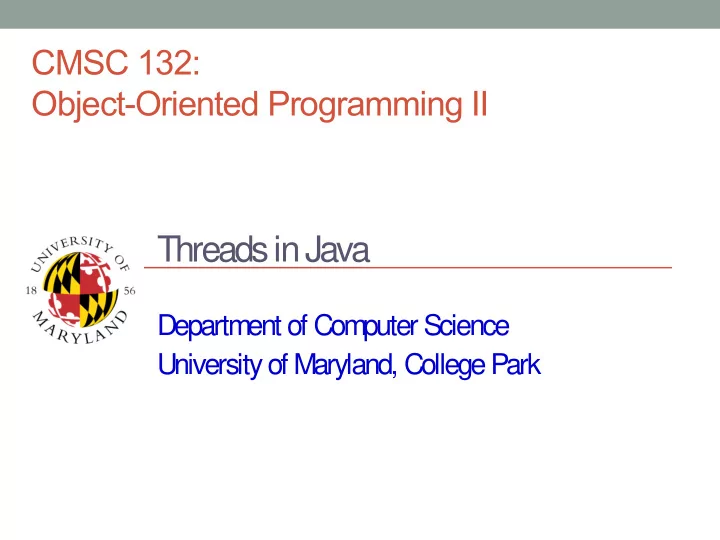

CMSC 132: Object-Oriented Programming II Threads in Java Department of Computer Science University of Maryland, College Park
Problem • Multiple tasks for computer – Draw & display images on screen – Check keyboard & mouse input – Send & receive data on network – Read & write files to disk – Perform useful computation (editor, browser, game) • How does computer do everything at once? – Multitasking – Multiprocessing
Multitasking (Time-Sharing) • Approach Computer does some work on a task – Computer then quickly switch to next task – Tasks managed by operating system (scheduler) – • Computer seems to work on tasks concurrently • Can improve performance by reducing waiting
Multitasking Can Aid Performance • Single task • Two tasks
Multiprocessing (Multithreading) • Approach Multiple processing units (multiprocessor) – Computer works on several tasks in parallel – Performance can be improved – Beowulf computer Dual-core 32 4096 cluster (Borg, AMD processor processor 52-node cluster used by McGill Athlon X2 Pentium Cray X1 University Xeon Image/Info from Wikipedia )
Perform Multiple Tasks Using Processes • Process – Definition executable program loaded in memory – Has own address space ● Variables & data structures (in memory) – Each process may execute a different program – Communicate via operating system, files, network – May contain multiple threads
Perform Multiple Tasks Using Threads • Thread Definition sequentially executed stream of instructions – Has own execution context – ● Program counter, call stack (local variables) Communicate via shared access to data – Also known as “lightweight process” – Let’s see how memory is organized for a threaded environment – Diagram – http://blog.codecentric.de/wp-content/uploads/2009/12/java-memory-architecture.jpg ●
Motivation for Multithreading • Captures logical structure of problem May have concurrent interacting components – Can handle each component using separate thread – Simplifies programming for problem – • Example Web Server uses Multiple simultaneous threads to handle … web browser requests
Motivation for Multithreading • Better utilize hardware resources When a thread is delayed, compute other threads – Given extra hardware, compute threads in parallel – Reduce overall execution time – • Example Multiple simultaneous Handled faster by web browser requests… multiple web servers
Programming with Threads • Concurrent programming – Writing programs divided into independent tasks – Tasks may be executed in parallel on multiprocessors • Multithreading – Executing program with multiple threads in parallel – Special form of multiprocessing
Creating Threads in Java • Two approaches to create threads Extending Thread class ( NOT RECOMMENDED ) – – Runnable interface approach ( PREFERED ) • Approach 1: Extending Thread class We overload the Thread class run() method – The run() methods defines the actual task the thread performs – Example – public class MyT extends Thread { public void run( ) { … // work for thread } } MyT t = new MyT( ) ; // create thread t.start( ); // begin running thread … // thread executing in parallel • Example: message, messageThreadExtends packages
Creating Threads in Java • Approach 2: Runnable Interface – Define a class (worker) that implements the Runnable interface public interface Runnable { public void run(); // work done by thread } – Create thread to execute the run() method ● Alternative 1: Create thread object and pass worker object to Thread constructor ● Alternative 2: Hand worker object to an executor – Example public class Worker implements Runnable { public void run( ) { // work for thread } } Thread t = new Thread(new Worker( )); // create thread t.start(); // begin running thread … // thread executing in parallel • Example: message, messageThreadRunnable packages
Why Extending Thread Approach Not Recommended? • Not a big problem for getting started – But a bad habit for industrial strength development • Methods of worker and Thread class intermixed • Hard to migrate to more efficient approaches – Thread Pools
Thread Class public class Thread extends Object implements Runnable { public Thread(); public Thread(String name); // Thread name public Thread(Runnable R); public Thread(Runnable R, String name); public void run(); // if no R, work for thread public void start(); // thread gets in line so it eventually it can run ... }
More Thread Class Methods public class Thread extends Object { … public static Thread currentThread() public String getName() public void interrupt() // alternative to stop (deprecated) public boolean isAlive() public void join() public void setDaemon() public void setName() public void setPriority() public static void sleep() public static void yield() }
Creating Threads in Java • Note – Thread eventually starts executing only if start() is called Runnable is interface – So it can be implemented by any class ● Required for multithreading in applets ● – Do not call the run method directly
Threads – Thread States • Java thread can be in one of these states – New thread allocated & waiting for start() – Runnable thread can begin execution – Running thread currently executing – Blocked thread waiting for event (I/O, etc.) – Dead thread finished • Transitions between states caused by – Invoking methods in class Thread ● new(), start(), yield(), sleep(), wait(), notify()… – Other (external) events ● Scheduler, I/O, returning from run()… • In Java states defined by Thread.State – http://docs.oracle.com/javase/6/docs/api/java/lang/Thread.State.html
Threads – Thread States • State diagram new start notify, notifyAll, new runnable IO complete, sleep expired, join complete scheduler yield, time slice running blocked IO, sleep, terminate wait, join dead Running is a logical state → indicates runnable thread is actually running
Recommend
More recommend